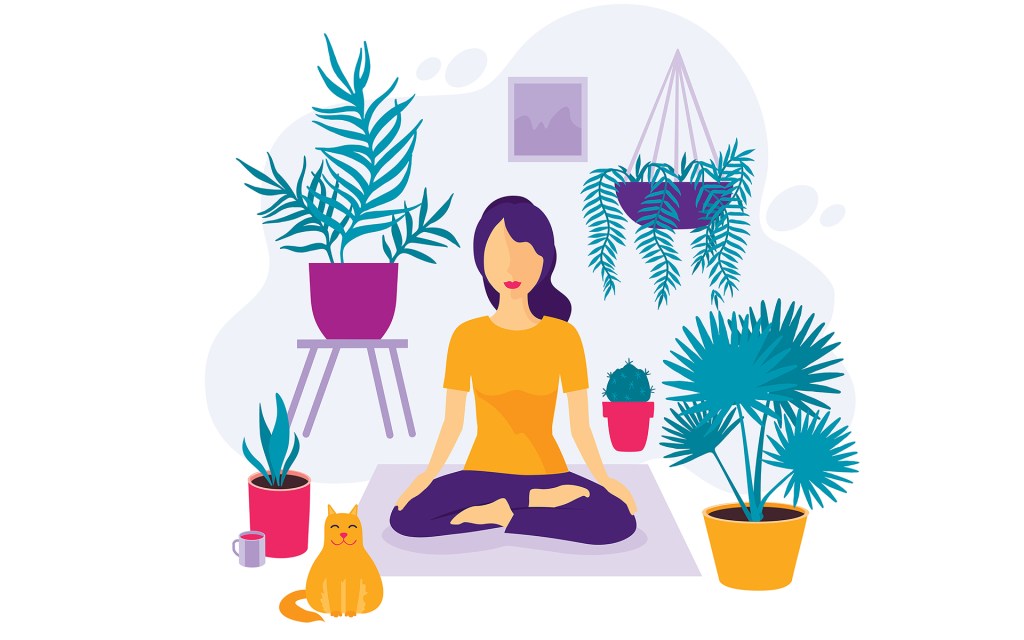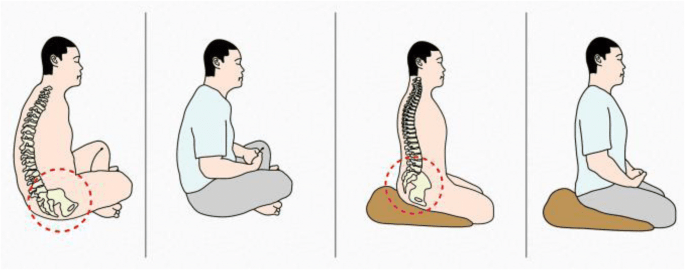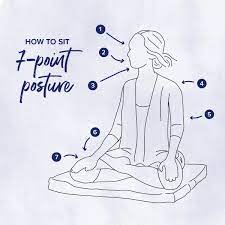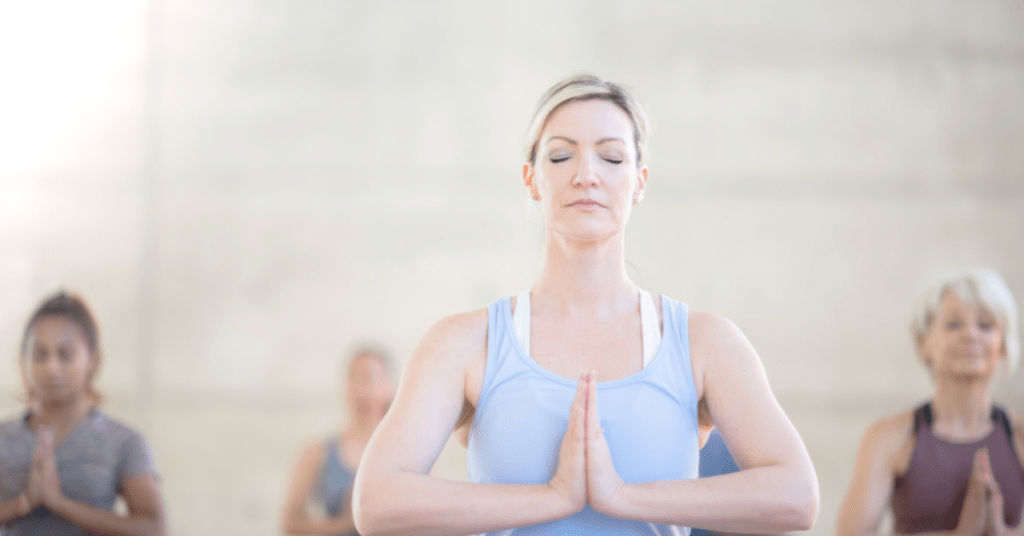Contents
What is Meditation?

Meditation is a practice that has been around for thousands of years. It’s become popular in recent decades due to benefits such as stress reduction and reduced symptoms of depression, anxiety, and pain. However, many people who want to start meditation don’t know how to get started or what they should do once they’re sitting down. Sitting is an important part of meditation. If you are new to meditation, the sitting posture can seem like a daunting task. Proper sitting posture can help you feel more grounded and present in your meditation practice.
What is Meditation Posture?
Meditation posture is important because it can be both uncomfortable and distracting to have your body slouching or hunching over. When sitting, it’s best not to cross your legs or lean back against the chair with your back. The goal of meditation is to find that still place where you can focus on yourself without any pain or discomfort getting in the way. So make sure you’re doing everything possible for a comfortable experience when meditating.
Different Types of Meditation Posture
Good meditation posture involves sitting tall but not stiffly with an open body that doesn’t feel closed off. Try different positions until one feels right for your body type and just remember to take breaks if necessary.

- Chair Sitting Position: This is a posture where you can sit in the chair with your feet on the ground and spine straight.
- Lotus Position: One foot is placed over the other leg, which can be repeated for both legs if you are more comfortable that way.
- Half Lotus Position: This means that one of your feet is under your body’s knee while sitting cross-legged on a cushion or pillow.
- Buddha Posture: A half-lotus where each ankle rests above its respective thigh so it looks like an upside-down “U.”
- Burmese Position: Feet extended forward resting flat on the floor, heels together pointing toward the ceiling. The spine should remain upright but not rigid; shoulders relaxed. The neck can either stay completely perpendicular to earth or slightly inclined backward towards the sky (in the direction of your third eye).
- Kneeling Position: On all fours with spine straight, hands below shoulders, and knees below hips. Shoulders should be relaxed away from ears; the neck can either stay completely perpendicular to earth or slightly inclined forward towards the sky (in the direction of your heart).
Some More Uncommon Different Types of Meditation Posture

- Cobbler’s Pose: Sitting cross-legged on a pillow or cushion with spine erect. Hands rest palms up one on top of the other in lap while feet touch both thighs at once pointing toward the ceiling. Elbows are tucked inside the body so they don’t stick out to sides like wings. The relaxed but alert expression on the face is key here!
- Corpse/Savasana posture: Lying flat on back with arms resting at the side on the ground, legs straight with feet falling open naturally. Eyes are closed and the chin is dropped slightly towards the chest so neck muscles can relax fully. The Head should be resting on a pillow or cushion if it doesn’t touch the floor directly (which some people prefer).
- Standing Position: The standing position is when you are in the traditional “feet together, eyes closed” position. You can do this by raising your hands in front of your chest with palms facing up. You can even just have them at your side. Start relaxing your neck by tilting it toward the ground.
Benefits of Good Meditation Posture
These are some of the benefits of practicing Meditation in a good meditation posture:
- The benefits of good posture are that you will be more comfortable and in better shape. Your muscles will feel less tense, your back won’t ache after meditating, and you’ll have less neck or shoulder pain. You’ll also be able to move around more easily without feeling stiff.
- Those who meditate with good posture will find that they are better able to focus on their own thoughts and emotions. It’s also easier to concentrate when your muscles aren’t tensed. So you’ll be able to think more clearly about what you’re doing.
- It should take less time for someone with proper meditation posture to achieve a state of stillness because the body is in better condition. This means it should happen faster for anyone new to meditation, or you can go deeper into meditation without losing focus or energy because of your position.
- Meditation posture is important because it can help you find that still space within yourself without being distracted by pain or discomfort. It can also help improve your concentration so you have better focus while meditating.
Right Position for Your Body Type
The right way to meditate while sitting involves sitting tall, but not stiffly. For men, it may be easiest to sit cross-legged on the floor while resting buttocks on another cushion placed under the feet. Women may find it easier to sit on the floor with legs tucked under their buttocks. This is because they don’t fall backward while meditating. Men can try sitting in a chair with their legs uncrossed and feet flat. They should place one foot over the other thigh, or both feet parallel if that feels comfortable. Women can also sit in chairs but need to avoid crossing their legs because it closes them off from the universe which is what you’re trying to do during meditation anyway.
If you have back problems, certain allergies, or medical conditions like scoliosis, talk to your doctor before attempting any of these postures and make sure you’re following proper posture for that specific condition.
Remember that no matter how good your posture is, you will not be able to stay in the proper pose for hours. If your mind starts wandering or becoming unfocused, then you are probably starting to feel uncomfortable. Take a break if this happens and try again later when it’s more comfortable.
Common Mistakes While Trying Meditation Postures

Some are common mistakes that people make when trying out new postures. These involve staying in the wrong pose for too long and not taking enough breaks. It’s good to remember that no matter how good your posture is, you will still get tired and lose focus. It’s important to take breaks. If you feel like you need a break, just close your eyes and come back to the meditation after a few minutes of relaxation.
Some People may struggle with finding the right meditation posture. This can be because they don’t meditate on a regular basis; may want to try sitting down in their most comfortable chair or lying down flat on their bed with their legs uncrossed and feet resting slightly apart. These positions are good for someone who is new to meditation. It will help them find that still place where they can really focus on themselves. It helps without being distracted by pain, discomfort, or other problems.
It’s important to remember that everyone has different needs when it comes to proper meditation posture. For some people, sitting up straight isn’t stressful enough so they need more tension in their bodies. However, doing this can cause muscle cramps if you’re not in the position so keep that in mind when trying to find your meditation posture.
How to Avoid These Mistakes?

People with back problems, certain allergies, or medical conditions like scoliosis should talk to their doctor before attempting any of these postures. Make sure they’re following proper posture for that specific condition. Meditation can be great because it’s a way you can focus on yourself without all the distractions in your daily lives but you need a good meditation posture to fully enjoy the benefits of this ancient practice.
Remember that no matter how good your meditation posture is, it will not last forever. If you feel like you need a break, just close your eyes and come back to the session after relaxing for a few minutes. There are many ways to meditate but only some provide the relief from pressure and tension that your body needs. It takes time to find the right way for you but when you do, it will be well worth the effort because it can help improve your overall health and wellbeing. Good meditation posture can also lead to improved concentration so your focus during meditation is better than ever before. Getting comfortable in this pose may take some experimenting but once you’ve found it, you won’t want to leave.
What is the Seven-Point Meditation Posture?

Sit down in a comfortable and stable position. Make sure you’re not going to fall over! You can sit on the floor or use a chair, whatever is best for your body type. Remember that mediation only works if it’s comfortable. So make sure your posture isn’t hurting too much before starting. It helps with physical comfort as well as mental clarity. Follow these steps for a chance at meditation mastery:
First Point
The first point is to have your spine in an upright position, but not so straight that it hurts the back or neck. If you are sitting on the floor make sure your knees are lower than your hips. Make sure there isn’t any bend in the torso when coming into this posture. It can cause pain and tension later on during practice. This will help prevent strain throughout the body while practicing meditation which leads to better relaxation overall.
Second Point
The second point is for both of your hands with palms up resting at about shoulder-width apart from each other forming a triangle shape if viewed from above. You don’t want them too close together or too far away from where they’d be uncomfortable most people’s arms/hands.
Third Point
The third point is for both of your feet to touch each other or be close enough. It is so that they don’t feel uncomfortable. If you are sitting on the floor make sure not to cross your legs. It can cause pain and tension later on during practice. This will help prevent strain throughout the body while practicing meditation which leads to better relaxation overall.
Fourth Point
The fourth point is having a relaxed face, especially around the eyes and jaw. You should feel like all muscles in this area have gone limp so there isn’t any tightness or discomfort at all. Make sure you’re not clenching jaws together as well either because that causes tension over time which doesn’t lead towards mental clarity but rather stress instead.
Fifth Point
The fifth point is having a relaxed neck, shoulders, chest muscles, and stomach area. You should feel like all muscles in these areas have gone limp so there isn’t any tightness or discomfort at all! Make sure you’re not clenching jaws together as well. It causes tension over time which doesn’t lead towards mental clarity but rather stress instead. Remember to keep breathing while practicing meditation too – don’t hold your breath. This will help prevent strain throughout the body while practicing meditation which leads to better relaxation overall.
Sixth Point
The sixth point is having a relaxed tongue (touch the tip of your nose, then move it down and touch the roof of your mouth). This helps with blood circulation in that region which can cause feelings of tiredness or discomfort. It can happen if you’ve been practicing meditation for long periods already. Remember not to clench jaws together as this causes tension over time though. Ensuring these muscles are limp greatly aids mental clarity too. It is because focusing on one thing becomes easier when all other parts aren’t tense. It can be due to meditation practice such as this posture here.
Seventh Point
The seventh point is keeping eyes closed or have them open but unfocused on anything in particular. In addition to staring at a wall if eyes closed are too difficult you can also try focusing your attention towards the center of the room instead. It will help calm those wandering thoughts as well which reduces stress and anxiety from trying to achieve mental clarity.
Conclusion
When you meditate, your brain produces a chemical called serotonin. This hormone can make people feel happy and contented with themselves. This is why many people find it helpful to deal with stress or anxiety. In addition to that, meditation helps clear the mind of thoughts. It helps so that the person can focus on one thing at a time. You can focus without being distracted by their worries or anxieties. If this sounds like something you’re interested in, try some of these different types of meditation techniques for beginners. You may just be surprised about how effective they are.
If you are looking for affordable Online Counseling MantraCare can help: Book a trial therapy session


